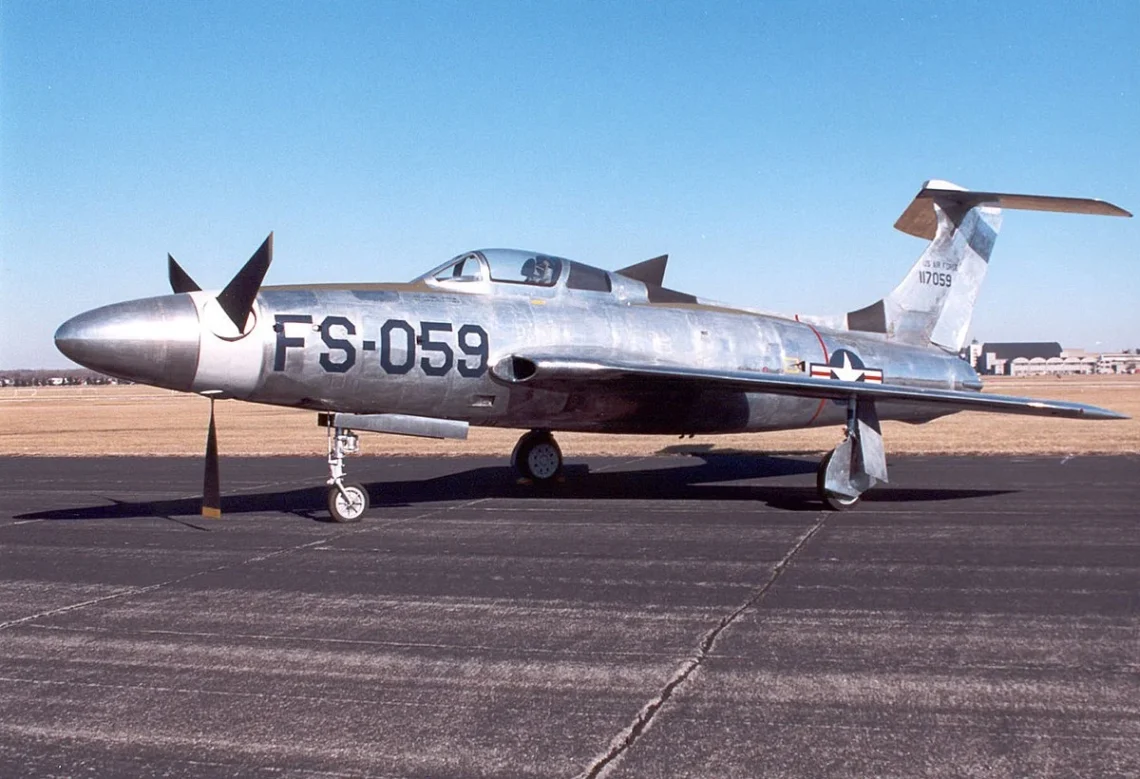1. The Birth of the XF-84H Thunderscreech: A Propeller with a Mach 1 Bite
Fairchild Republic XF-84H Thunderscreech: The Republic XF-84H “Thunderscreech” was an ambitious twist on the existing F-84F Thunderstreak design. Developed in the early 1950s, it was intended to blend jet-like speed with prop-driven efficiency, powered by a turboprop—a fascinating engineering hybrid
Equipped with an Allison XT40-A-1 turboprop delivering around 5,850 shaft horsepower, it turned a massive 12-foot diameter supersonic propeller. The concept: leverage the responsiveness of prop-driven aircraft without sacrificing speed.
2. A Sonic Nightmare: The Loudest Plane Ever Created
The XF-84H didn’t get the nickname “Thunderscreech” for nothing. Ground crews reportedly heard it from 25 miles away, and supersonic propeller tips produced constant sonic booms, generating over one hundred shock waves per second.
One engineer even suffered a seizure due to the noise. The aircraft became so intolerably loud that Edwards AFB staff moved test runs to remote dry lakebeds just to avoid disruption.
3. Design Challenges and Unrelenting Engineering Obstacles
To handle the immense torque and wash of the supersonic propeller, the XF-84H included several unusual features:
- A T-tail and small vertical anti-torque fin aft of the cockpit to stabilize flight.
- Asymmetrical wing-root intakes and differential flaps to offset engine torque.
- A deployable ram air turbine used during tests as a precautionary power backup.
Despite the innovative engineering, most of the 12 test flights ended in emergency landings. The pilots faced severe propeller governor surging and uncontrollable yaw at high speeds. One test pilot famously told engineers, “You aren’t big enough, and there aren’t enough of you to get me in that thing again.”
4. Performance Capabilities and Inevitable Failures
Though designed to be a high-performance turboprop, the XF-84H never met its full potential:
- Maximum speed: Unofficially reached 520 mph; some estimates speculated even higher.
- Range and service ceiling: Over 2,000 miles and above 40,000 ft.
- Out of the two prototypes, one was scrapped; the other ended up as a static display.
Ultimately, the design was canceled due to mechanical complexity, fragility, noise, and impractical operational needs.
5. Legacy and Exhibition: The XF-84H Lives On in Museums
Despite the program’s failures, the XF-84H earned a lasting legacy. The surviving aircraft was displayed at Meadows Field, Bakersfield, before being meticulously restored by the Ohio Air National Guard. It’s now showcased in the Research & Development Gallery at the National Museum of the U.S. Air Force in Dayton, Ohio.
Today, it stands as a reminder of Cold War-era innovation—and the risky extremes of experimental aviation.
6. The XF-84H’s Place in Aviation History
| Aspect | Details |
|---|---|
| Purpose | Turboprop fighter seeking jet-equivalent performance |
| Notability | Infamously loud aircraft; loudest ever built |
| Performance | Top speeds around 520 mph; extensive torque and mechanical issues |
| Flight Trials | 12 flights, 11 emergency landings |
| Legacy | Strong engineering ambition, ended in failure-to-operational reality |
| Today | Museum displayed piece symbolizing aerospace audacity and creativity |
Conclusion
The Fairchild Republic XF-84H Thunderscreech represents one of the most ambitious—and bizarre—experiments in aviation. It pushed the limits of speed, power, and engineering to create an aircraft of unmatched sound and form. Though it ultimately failed to enter operational service, the XF-84H remains an enduring testament to bold innovation and the extremes of aerospace experimentation.




